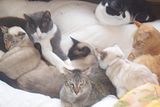http://ucat.us/FELVFIVFIP.html
that site isn't completely up-to-date, but as of about a year ago, it had the most accurate information available.
www.catvets.com (the american assn of feliine practioners' new web addy) and the winn feline foundation (www.winnfelinehealth.org) both have new guidelines/information on current research and information on both FIV and FeLV.
the MOST important resource for FeLV, however, is the most recent Merck Vet Manual publication (http://www.merckvetmanual.com/mvm/in...ine%2cleukemia) because it puts into print, from a pretty much unassailable source, the figures that have long been anecdotal in the sanctuary and FeLV-owned households: that healthy, adult cats can be exposed to the virus, they can pick up the virus, but a very high percentage will either not become infected, or will process it out of their systems.
it's long been noticed, also, that there seems to be a natural immunity that develops once a cat passes a year of age, and the new vaccines are roughly 95% effective. so: it is NOT as contagious as we used to think, mutual grooming is currently thought to be the most common mode of transmission (even for kittens--when we used to think that transplacental transmission accounted for positive results in kittens), and while there is no formal research supporting it yet, there is extensive anecdotal evidence to show that vaccinated (and, actually, even unvaccinated) healthy adult cats can live with positives with their being no infection. no one can officially say this, of course, because the first line of treatment has long been, and continues to be, killing all positives based on a single snap test, which seriously limits the population available for research purposes.
has the kitty--who is GORGEOUS, btw--been retested since the original test? if not, you cannot assume that it is positive. something we did NOT know, even as recently as five years ago, is that it can take up to 90-120 days for the virus to process itself out of a cat's system--so a positive test MUST be repeated. actually, all the textbooks have said that for YEARS, but it seems that way too many vets haven't bothered to notice that. additionally, while snap tests are traditionally more accurate for FeLV than for FIV, there is still always the possibility of a false positive: not doing snaps correctly (because they've gotten involved in something else, generally) is one of the top ten mistakes that vets admit to--i've got the citation for that someplace. i have EVERYTHING someplace.) i know of two sanctuaries that have discovered, happily living amongst their FeLVs for years, negative kitties who initially tested positive, because no one knew that retesting was so important.
one of the better known sites for posting adoptables is http://www.adopt.bemikitties.com.
final note: when you are looking up stuff about FeLV, pay close attention to the DATE the article was published. so much more is known now that anything older than 3 or 4 years is probably at least partially out-of-date, and while the basics will be unchanged, you may have to look for more current stuff--as from the winn feline foundation, or aafp--to find the updates.
MC








 Reply With Quote
Reply With Quote


 are on the way.
are on the way.




Bookmarks